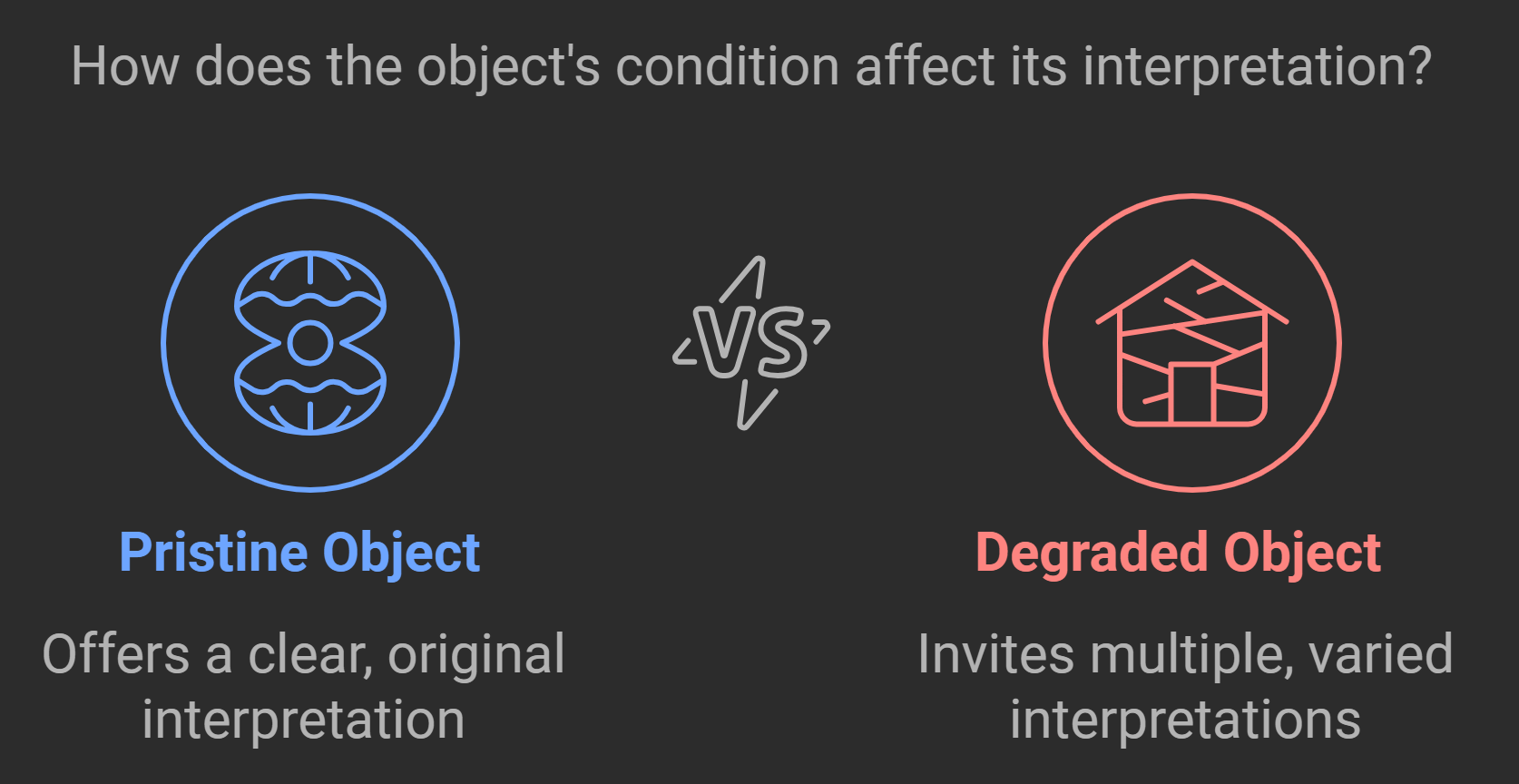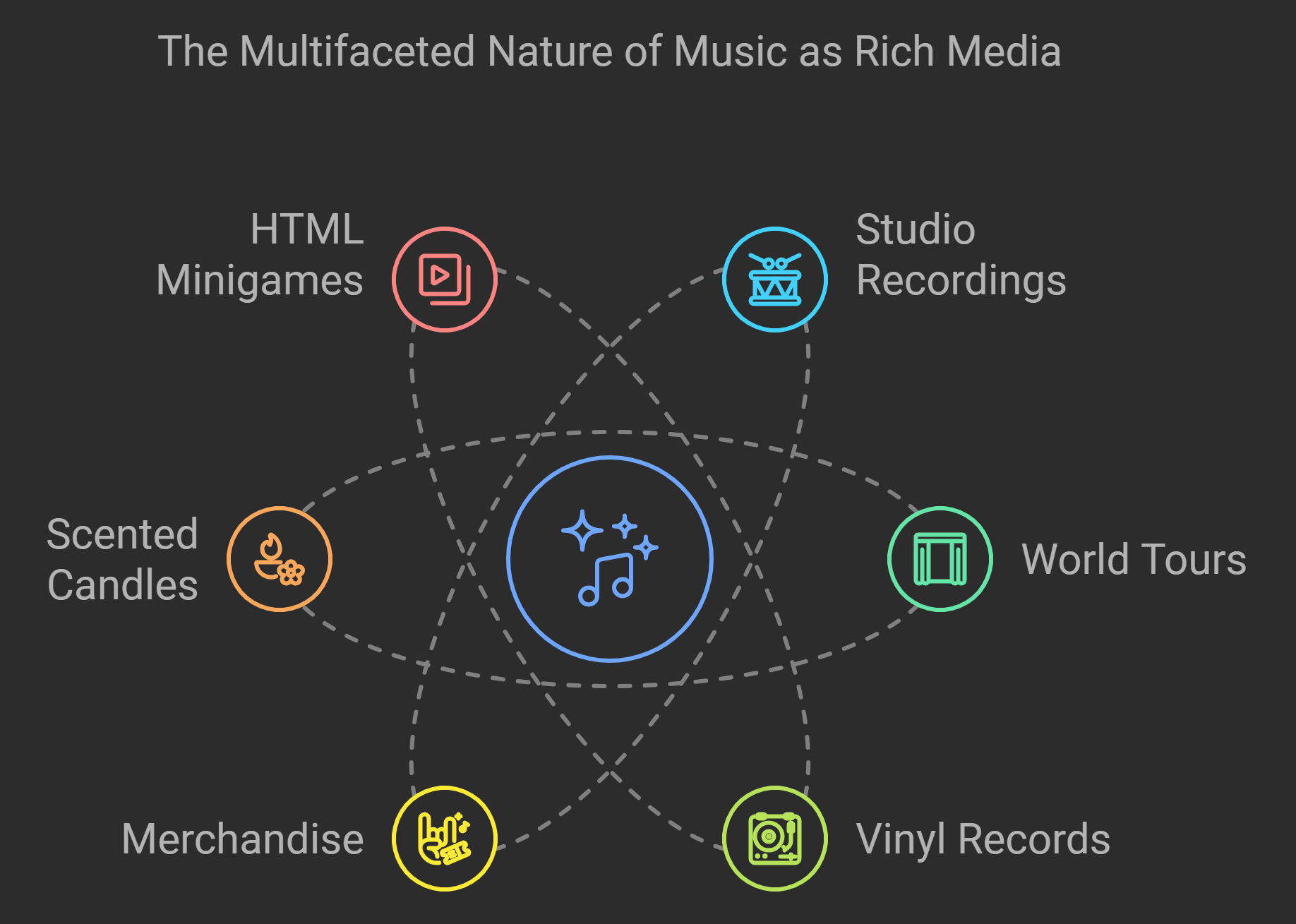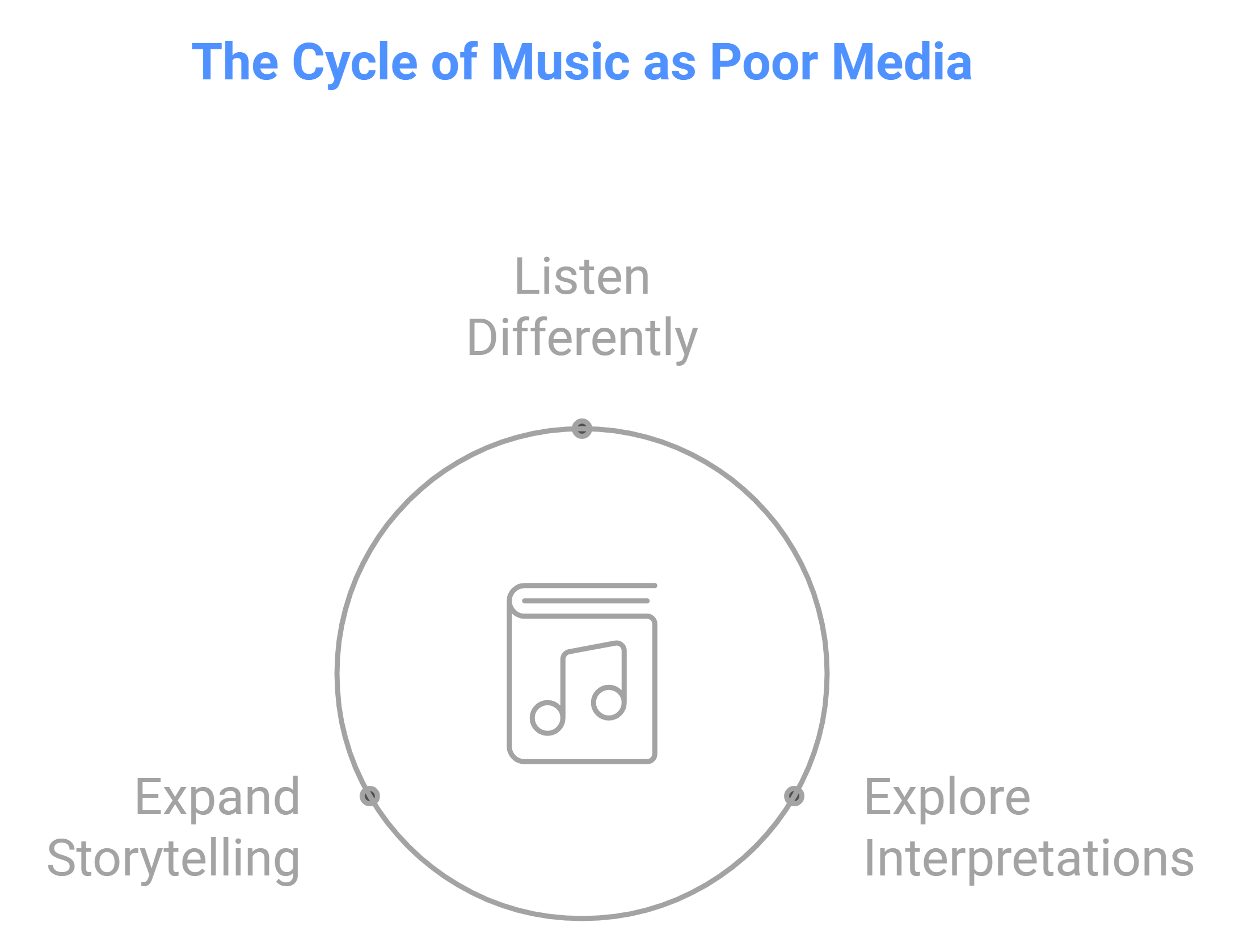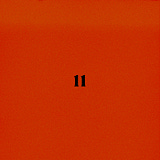✘ In defence of music as poor mediaAnd: More Indian artists on the world stage?; Resale caps & dynamic pricing; AI in music marketing; Networked cooperative ecosystems; The Cure into twilit woods“The music industry is broken.” How often have you heard someone say this? Even I say it from time to time. The statement sits on a similar spectrum to comparing music revenues (recorded music through the IFPI or the total value of copyright through Will Page) to another industry: gaming, fashion, you name it. We love finding ways to talk ourselves down. A crucial element in all this is that the thinking behind these statements and comparisons rests in an embedded notion that music is about putting out records. We are, however, moving away from the record as the cornerstone of the music industry. All around us we see little pockets of what this might look like - the promise of new economies built around artists we witnessed in the NFT hype; artists building their own AI models to expand their creative intelligence; world-building exercises from mini-games to fan interactions. To truly understand these, we need new concepts to think about music: as rich media and as poor media. In our world of broken data, this can help us find guardrails and point us towards possibilities. What is rich and poor media?The notion of poor media goes back to a piece by German filmmaker and artist Hito Steyerl from 2009. There, she wrote in defense of the poor image:
By extension, the rich image is the opposite of this. Post-produced, clean, perfect, conveying what the creator intended, and a definite visual idea. The poor image is in a sense a degradation of the rich image, caused by ripping it, sharing it, compressing it. When this happens, the poor image can also start to live its own life - become its own thing, its own idea, its own concept. What Steyerl argues, is that this poor image becomes something valuable in its own right. It’s valuable first because it becomes a way of rebellion against the structures that dominate and determine the culture of the rich image. If the end game is the Marvel Cinematic Universe, the opposite is a grainy picture which doesn’t have the same amount of visual richness. That lack of visual power can become the strength of the poor image. It will not feel like a final product but instead invites the onlooker to imprint their own story on it. Rich media, Paul Soulellis argued in 2015, “are meant to bring to life an otherwise inert artifact by adding a ‘magical‘ element to the printed page.” Magic, as Bas once argued in this newsletter, is one of the generatives that allow the digital experience to shoot beyond real life experiences. Soulellis goes on to argue how in the context of publishing and other examples, rich media historically became about the presence of it. This is a reflection of a lot of innovative technology. Take NFTs, they were valuable mostly because they’re NFTs - the shiny new thing - and not because of the underlying art. An interesting exception can be said to be those experiments where the media connected to the NFT was part of the blockchain - and thus limited and thus not rich. Rich media versus poor media is a reflection of artistic ideals. It’s also a reflection of status. And, it’s a reflection of economic rich versus poor. Throughout all of these distinctions lies a trove of data that is increasingly disconnected. Over time it becomes more and more difficult to understand the building blocks and where an image, or a sound, has come from. Broken dataBack in 2006, geographer Caitlin DeSilvey, argued that we need “to accept that the artefact is not a discrete entity but a material form bound into continual cycles of articulation and disarticulation.” What she asked of herself, and her fellow scholars, was to open up to the possibility that a material object can first be interpreted in different ways. Second, that these interpretations are subject to the state the object is in. A pristine object versus a heavily degraded object will present vastly different interpretations - even if they were once very similar objects. Our current data streams and systems of analysis aren’t that different. If we look at the music industry, the state of data is “a landscape marked by a paradox: music professionals are awash in data, yet in many cases starving for actionable insights.” In other words, we live in a digital world with broken data or with so much data that we don’t know how to make sense of it. Inside all of this sits the audio file. A piece of data that has a long history of compression behind it. Moreover, the current recording process is heavily digitalized. From synthesizers to Autotune, and from the electric guitar to building your own VST plugin, it’s all bits of data coming together. All this data has a not too dissimilar materiality to the objects that DeSilvey researches. Broken data might not be broken at all, but present an opportunity.
Music is a crowded marketCompression plays a big role in our current digital music ecosystem. From the long history of the MP3 to bandwidth growth, it all influenced how we create, distribute and consume music nowadays. The fun creativity multiplied by the uncomplicatedness of distribution has led to an enormous overkill - and then we need to add generative AI - of music. It is also big business, especially for those at the top. But there are dangers for all players, large and small. The latter need to fight to get heard and find revenue streams. The former face a very different problem, recently well-articulated by Nemesis: “There is an inflection point in crowded markets where branded products lose ground to more generic, commodified ones; where narrative, story and brand are no longer necessary for success and can even get in the way.” The endgame here is that it’s no longer enough to be Taylor Swift, because there’s an endless battery of look-alikes and sound-alikes. Of course, the magic of music will dictate that there’s always someone we are drawn to. However, we also know that artists like Taylor are more like a brand than an artist. For the majors, developing these brands is the focus now. And yet, this also leads to a point-of-no-return, and a potential to look at music-as-art differently. Music as rich mediaMusic as rich media is the old-school recording - that finished product coming from a high-end studio where multiple brilliant people worked on a record together. Music as rich media is also the perfectly choreographed world arena tour. Just like it is the 9-edition vinyl record in combination with the merchandise for every occasion. It’s the scented candle and the HTML album minigame. Music as poor mediaMusic as rich media is experiencing a period of intense homogenization. We see all rich-media music through the same lens. Here is a perfect opportunity for music as poor media - music that is sophisticated only in its power to invite interpretation. Here, we can imagine anything from degraded audio files to 8-bit music. We can also imagine the continuous playing of a saxophonist like Evan Parker, where his saliva becomes a part of the music as it starts to accumulate in his soprano saxophone. Or, we can imagine artists like PortraitXO who are so future-gazing that they explore the edges of what’s possible in the connections between audio, technology, and visuals. What these examples show, is that music as poor media isn’t about quality per se. It’s about understanding music as a space for exploration and interpretation. Music as poor media allows us to listen differently and to expand the field for telling stories - away from the walled gardens of rich media. Think about the glitch, so important in genres as varied as IDM and Hyperpop. But also important in the sense of Legacy Russell’s Glitch Feminism Manifesto:
Music as poor media is also a correction to the machine it stems from and necessarily operates in. As artists, it’s possible to move in the direction of music as poor media, of music that is mutable and subject to versioning. Every encounter can be a starting point, a departure. As listeners and audiences, it’s possible to move in the direction of music as poor media, of music that changes when you touch it and where the narrative alters when you play it. Friend of the newsletter Rania, perhaps better known as PortraitXO, got mugged at Barcelona Airport recently. Unfortunately, this meant that a lot of her gear got stolen, including some not-yet-backed-up new work. She started a GoFundMe, and I urge you to help her out. LINKS🇮🇳 What will drive more Indian artists on the world stage? (Srishti Das)“Now that some artists have found their way into breaking out of the bubble and have begun to create strong, stable and distinct fanbases, the ecosystem to support these artists needs to and is slowly evolving. A great example of this is California-based Punjabi artist Talwinder, who, over a short period, has gathered a large youth audience across South Asia, using social media as a tool to stay connected with fans and creating an audio-first fandom that spills over onto every other platform Talwinder is live on.” ✘ The non-Bollywood Indian music market has been really interesting to follow. From the indies to the majors, and from the DSPs to social media, the sense of the next global superstar coming from this massive country is palpable. 🎫 Ticketing businesses, experts debate resale caps and dynamic pricing (Tara Deschamps)“Catherine Moore, an adjunct University of Toronto professor specializing in the music business, said a lot of problems stemming from the price of tickets start long before seats land on resale sites. When acts announce they're touring and set dates for ticket sales, fans are seldom told what seats will cost and how many will even be up for grabs.” ✘ It would be so interesting to see what happens when this kind of transparency comes into play. 🔧 AI’s Practical Applications in Music Marketing and Fan Engagement (Virginie Berger)“AI’s ability to analyze fan data and create customized content is transforming marketing strategies. From personalized news articles and videos to AI-generated art and merchandise, the possibilities are vast. For instance, AI can create customized social media posts, captions, and stories tailored to individual fan preferences. It can even compose playlists for fans.” ✘ I love this practical overview, especially since it comes from one of the most vocal proponents in calling out copyright abuses around AI. It helps showcase how different forms of AI bring different viewpoints. 🕸️ Networked Cooperative Ecosystems (Rithikha Rajamohan)“Each of the selected case studies included here leverage digital tools to various extents, creating novel ecosystems for work. In lieu of defining the strength of an “ecosystem enabler” by the local networks to which it is attached, we sought to understand how each of the case studies promoted networks between workers or groups of workers internally. In other words, by trying to understand the collaborative and organizational strategies within each ecosystem, we could both define the edges of a particular ecosystem and assess whether it is successfully enacting its own social, economic, and political visions.” ✘ There are a lot of ways to work together as humans. Cooperatives are one of these ways, and they have historically brought a lot of freedoms and opportunities for those involved. Pushing the needle towards digital cooperatives and thinking about them as networked both in their situated place and online is a very valuable exercise. 💊 The Cure: Go into the twilit woods, alone (Sean Adams)“Whilst many artists build immersive installations or digital playgrounds or fancy concepts involving elves or whatever, The Cure have - over their decades of exceptional work - mastered the art of soundscaping something that emerges inside of you as the music unfurls. And anyway, their lost world is a medicinal dose of hope and humanity in the face of hopelessness. It's an Atlantis, drifting in a romantic fug and a gentle fury, which is just what the doctor ordered.” ✘ I can get on my soapbox from time to time to bemoan the lack of good writing about music. The kind of writing that takes music seriously and engages with it. Sean doesn’t do the latter, but he does do the former. It’s a great piece about a great record. MUSICOn the topic of that last piece about The Cure, music has this great power to alter our states of being. I was recently - you all know why - reminded of this quote by C.S. Lewis:
In this spirit, I encourage everyone to find some music to support them in these endeavours. For me, I like the call of Sault, who’s Fighting for Love can also reflect on these personal spaces we have influence on.
MUSIC x is free today. But if you enjoyed this post, you can tell MUSIC x that their writing is valuable by pledging a future subscription. You won't be charged unless they enable payments. |




